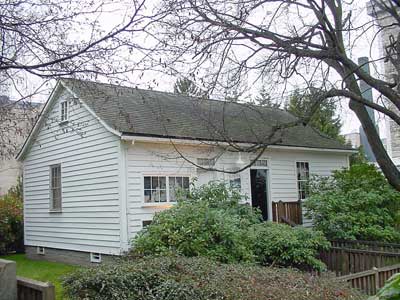Heritage Register
James Bay
637 Elliot Street
St. Ann’s Pioneer Convent & Schoolhouse
(Originally on Park St, later called Heywood Av, now Academy Cl; now on grounds of Royal BC Museum
Built
1853; relocated 1966, 1974
Heritage-Registered
For: Leon & Adelaide Morell (Morel)

ARCHITECTURE:
This small log structure, built as a house in 1853, is the fourth-oldest building in the Capital Region. The cabin is built in the Hudson’s Bay Co method of log construction called pièce sur pièce. With an axe, logs are squared and tenons are cut on their ends. The tenons are slotted into grooves cut into upright posts. As the logs shrink, they settle onto the lower logs, keeping the walls relatively tight. The roof is made of pairs of rafters, joined at the top with half-lapped joints, held together with wood pegs. Small, curved rafter ‘extenders’ project the roof out over the exterior walls, adding a bellcast profile.
ORIGINAL OCCUPANTS:
Leon Morell purchased Victoria Town Lot 358 in 1853 from the Hudson’s Bay Co for $50. The lot was in two parts: a small portion, where he had the house built, backed onto Beacon Hill Park, and a larger portion across Park St sloped down to the stream that used to run through the Humboldt Valley. The larger part provided space for a garden, a well, and a laundry near the water source.
Morell, a French Canadian, had been an HBC trader since at least 1840. He was at Fort Vancouver and Fort Stikine before Fort Victoria. He and Adelaide, who was Stikine, formally married in 1852, although they had been together for some years, and had six children. Adelaide died in 1855, and was the first documented burial in the Old Burying Ground, now Pioneer Square (1030 Quadra St, Fairfield).
OTHER OCCUPANTS:
After his wife’s death, Morell made an agreement with Bishop Modeste Demers to sell the lot and cabin for $500, for use by the Sisters of St. Ann. (Ownership, however, wasn’t actually transferred until 1864.) Demers then travelled to Quebec to recruit Sisters of St. Ann to teach and to help with nursing and orphans. Four French-speaking Sisters and a female lay assistant arrived on June 5, 1858, in the middle of the Gold Rush, when Victoria was surrounded by tents. Bishop Demers led the Sisters to their new home, which they found dirty and abandoned since Mrs. Morell’s death, with no furniture. The Sisters initially slept on the floor and used their aprons for window curtains.
Their first home was just 18’ by 30’, with wood siding on the exterior, exposed logs on the interior, and a good wood floor. The ceiling beams were structural, but initially there was no ceiling. There were two rooms, one large, one small, separated by a rough plank partition. There was a door front and back, each flanked by windows, and a window at each end. The roof gables also had windows. There was at least one stove with stovepipes, and a “double chimney,” seen in early images of the building. The bricks of the chimneys were limited to the attic and roof for fire safety, and supported on a platform nailed between the roof rafters, providing a safe, fireproof outlet for the stovepipe through the wood shingle roof.
A few days after their arrival, the Sisters took in children and started a school. In the late fall of 1858, the log building was doubled in size, the new wing providing a chapel and accommodation for the Sisters. It had a ‘gallery’ (small attic space), and a small steeple that held a bell named “Pierre.” At the same time, a staircase was added to the original cabin, and the low attic had a floor added, making a space where students and orphans could sleep.
The original cabin was used as a school for only two years, until a new primary school was built on View St at Broad St. The log cabin and addition then provided a home for the Sisters, orphans and students, until their own large brick building – the first wing St. Ann’s Academy (835 Humboldt St, Fairfield) – was constructed in 1871. The addition to the log cabin was demolished about the mid-1890s. The Pioneer Convent & Schoolhouse was retained as an important memory of the arrival of the Sisters of St Ann in Victoria, and was the focal point for celebrations each June 5, on the anniversary.
The cabin was used for several purposes, including as a residence. About 1908 an extra door was added on the south side, as was a horizontal window made from two recycled sash windows. However, by 1929 the cabin was in very poor condition. For the 1933 Diamond Jubilee (75th) of the Sisters in Victoria, the cabin was rebuilt and restored, and a marble plaque was hung. The exterior received new, slightly wider, bevelled siding, the interior had new flooring and vertical board panelling installed, with a ‘window’ in the panelling so the logs were visible. A garden was planted, replacing the waist-high weeds.
In 1966 the Sisters had the cabin moved across Heywood to W of St. Ann’s Academy auditorium. The cabin was turned 180º so the N-facing front façade now faced S. In 1974 it was moved with the assistance of the Victoria Real Estate Board to a site opposite Helmcken House, making a small heritage precinct to the east of the BC Provincial Museum (now The Royal BC Museum). The front facade still faces South, and the building is now used by the museum as an interpretive area for early education for school groups and is frequently open to the public.
Researched & written by Stuart Stark
ADDITIONAL INFORMATION & IMAGES:
• James Bay History
• James Bay Heritage Register
• This Old House, Victoria's Heritage Neighbourhoods,
Volume Two: James Bay

